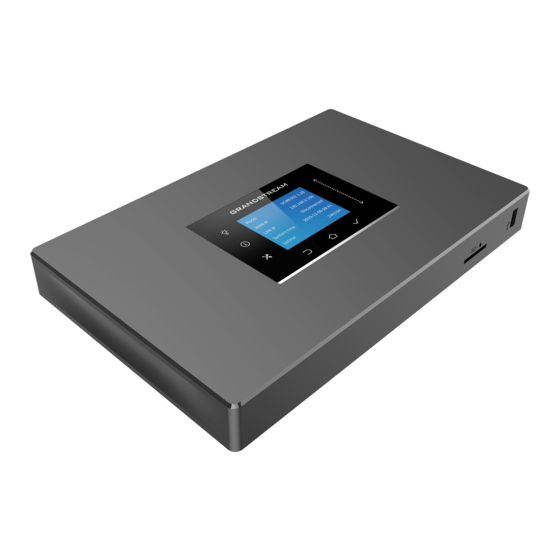
Grandstream Networks UCM630X Series Setup Manual
Ip pbx
Hide thumbs
Also See for UCM630X Series:
- User manual (591 pages) ,
- Quick installation manual (6 pages) ,
- User manual (423 pages)
Summary of Contents for Grandstream Networks UCM630X Series
- Page 1 Grandstream Networks,Inc. UCM630X Series IP PBX Remote Work Environment Setup Guide...
- Page 2 Table of Contents OVERVIEW ........................4 SIP SIGNALING TRAVERSAL ..................5 MEDIA TRAVERSAL ...................... 9 CONFIGURING FOR WAVE ..................12 P a g e...
-
Page 3: Table Of Contents
Table of Figures Figure 1: SIP Signaling Penetration - UDP Port ................... 5 Figure 2: SIP Signaling Penetration - TCP/TLS Port ..................6 Figure 3: SIP Signaling Penetration - NAT Settings ..................7 Figure 4: RTP Settings – RTP/BFCP Ports ....................9 Figure 5: SIP Settings - STUN/TURN Server ..................... -
Page 4: Overview
UCM RemoteConnect, it is the perfect solution to improve communication efficiency and productivity. The UCM630X Series IPPBX offers UCM RemoteConnect, a service which allows users to quickly set up remote communication and management using Grandstream Wave. Grandstream Wave is a multi-platform... -
Page 5: Sip Signaling Traversal
SIP SIGNALING TRAVERSAL To allow successful SIP registration and call establishment, users will need to configure SIP signaling NAT traversal by associating their private local network addresses and ports with their public addresses and ports. To do so, please see the following steps: Step 1: From the UCM630X web UI, users can retrieve or modify their internal UDP port from the PBX Settings ->... -
Page 6: Figure 2: Sip Signaling Penetration - Tcp/Tls Port
Figure 2: SIP Signaling Penetration - TCP/TLS Port Step 2: Once the internal port information has been confirmed, users can then map them to the corresponding external ports on the router. Example: If the internal UDP port is 5060, users would map port 5060 to whatever is designated as the external UDP port for SIP traffic on the router. -
Page 7: Figure 3: Sip Signaling Penetration - Nat Settings
Figure 3: SIP Signaling Penetration - NAT Settings • Configure External Host with the public network address of the UCM630X. • Configure the External UDP Port, External TCP Port, and/or External TLS Port fields based on the router mappings created in the previous step. •... - Page 8 Configure the externally mapped TLS port when the UCM is behind a static NAT External TLS Port or PAT. The default setting is 5061. Configure a list of subnets under the internal network. Multiple entries are supported. This must be configured for successful NAT traversal. Local Network Address Example:...
-
Page 9: Media Traversal
MEDIA TRAVERSAL To ensure correct audio and video exchange between call parties on different networks, proper media traversal configurations are required. For IP endpoints, users will need to configure RTP and BFCP port mappings. For Wave, users will need to configure STUN and TURN server settings instead. Please see the following steps: Step 1: From the UCM630X Web UI, navigate to the PBX Settings ->... -
Page 10: Figure 5: Sip Settings - Stun/Turn Server
• For proper audio/video exchange, create an RTP port range mapping on your router. From the figure above, this would be 10000-20000. • For proper presentation sharing, create a port range mapping on your router. From the figure above, this would be 53000-55999. Step 3 (for Wave): Configure the STUN and TURN server settings as highlighted in the figure below. - Page 11 Configure the ending RTP port. Default is 20000. RTP End Enable strict RTP protection. If enabled, RTP packets that do not originate from Strict RTP the RTP stream source will be dropped. Disabled by default. Toggles UDP checksums on RTP traffic. Disabled by default. RTP Checksums Configure ICE support.
-
Page 12: Configuring For Wave
CONFIGURING FOR WAVE To successfully log in and use Wave, please see the following steps: Step 1: From the UCM630X Web UI, navigate to the System Settings -> HTTP Server -> Wave Settings section to configure External Host with the UCM630X’s public network address and retrieve/modify the Wave Port information. - Page 13 The port to access the UCM’s Wave portal. If behind NAT, please confirm that Port a mapping to this port has been configured on the router. P a g e...

















Need help?
Do you have a question about the UCM630X Series and is the answer not in the manual?
Questions and answers